Boehler-Almax Diamond Anvils
Conical aperture 2θ from 30° up to 120°
- Diamond anvils design developed in collaboration with Prof. Reinhard Boehler at the Max Planck Institute in Mainz, Germany
- Conical crown design offering superior mechanical stability achieved by a perfect match between the anvil and the tungsten carbide (WC) seat
- Smaller anvil reducing beam absorption
- Tungsten carbide seat with large aperture for diffracted patterns and signal
- Can be used both for optical spectroscopy measurements and for X-ray diffraction where large apertures (up to 120°) are required
Description
The table below provides you with all the different diamond anvils of this type. You can narrow down your choice using the filters below.
If you are in doubt about the meaning of each filter, more explanation is available in each of the tabs above.
Product Number
| Aperture
| Diameter (mm)
| Material
| Application | |
|---|---|---|---|---|---|
85° |
3.30 |
Diamond Type IIas |
Optical Raman ⋅ X-Ray ⋅ FT-IR |
||
85° |
3.30 |
Diamond Type la |
Optical ⋅ X-Ray |
||
70° |
3.10 |
Diamond Type IIas |
Optical Raman ⋅ X-Ray ⋅ FT-IR |
||
70° |
3.10 |
Diamond Type la |
Optical ⋅ X-Ray |
||
50° |
2.50 |
Diamond Type IIas |
Optical Raman ⋅ X-Ray ⋅ FT-IR |
||
30° |
2.50 |
Diamond Type la |
Optical ⋅ X-Ray |
||
80° |
4.00 |
Diamond Type IIas |
Optical Raman ⋅ X-Ray ⋅ FT-IR |
||
80° |
4.00 |
Diamond Type la |
Optical ⋅ X-Ray |
||
120° |
4.00 |
Diamond Type IIas |
Optical Raman ⋅ X-Ray ⋅ FT-IR |
||
120° |
4.00 |
Diamond Type la |
Optical ⋅ X-Ray |
||
70° |
3.30 |
Diamond Type IIas |
Optical Raman ⋅ X-Ray ⋅ FT-IR |
||
70° |
3.30 |
Diamond Type la |
Optical ⋅ X-Ray |
||
85° |
3.30 |
Diamond Type IIas |
Optical Raman ⋅ X-Ray ⋅ FT-IR |
||
85° |
3.30 |
Diamond Type la |
Optical ⋅ X-Ray |
||
85° |
3.30 |
Diamond Type IIac |
Optical ⋅ FT-IR |
||
70° |
3.10 |
Diamond Type IIac |
Optical ⋅ FT-IR |
||
50° |
2.50 |
Diamond Type IIac |
Optical ⋅ FT-IR |
||
70° |
3.30 |
Diamond Type IIac |
Optical ⋅ FT-IR |
||
80° |
4.00 |
Diamond Type IIac |
Optical ⋅ FT-IR |
Aperture and Diameter
Most likely the main parameter you will have to decide upon is the conical aperture 2θ required. We have a choice ranging from 30° up to 120° (X-ray). The schematic below shows the difference between optical (αO) and X-ray apertures (αX). Generally speaking X-ray diffraction will require larger aperture whereas for optical spectroscopy apertures up to 50° will usually be sufficient.
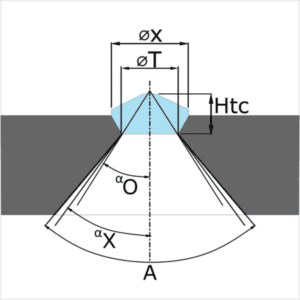
X (mm) – Diameter; α – Aperture; T(mm) – Table, Htc – Total height to culet
Material
| Diamond Type Ia | ~2×10³ ppm of nitrogen – yellow |
| Diamond Type Ia – Raman low / ultra-low fluorescence | ~2×10³ ppm of nitrogen – white to light yellow |
| Diamond Type IIac | ~1 ppm of nitrogen – white to light brown |
| Diamond Type IIas – Raman ultra-low fluorescence & ultra-low birefringence | ~1 ppm of nitrogen – white |
Almax easyLab is committed to its policy of continuous improvement. Specifications may change without notice. easyLab and Diacell are registered trademarks of Almax easyLab.
FT-IR Spectrum
 |
 |
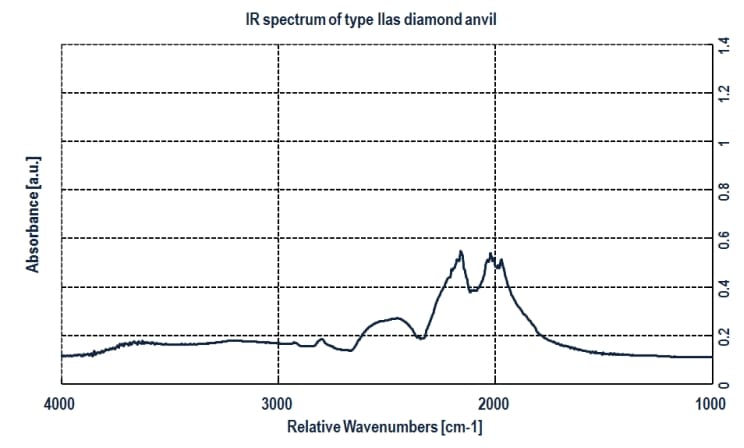 |
FLUORESCENCE
Almax easyLab can select its diamonds for low fluorescence. Standard measurements include laser excitation at 532 nm and covers fluorescence background in the range of 542 to 608 nm (Raman shifts between 1000 and 3000 cm-1). Measurements for different wavelength ranges can be made available on request. In special cases customers can select their own diamonds for low fluorescence using their own measurement set-up.
Almax easyLab classifies its diamonds with respect to fluorescence according to the following criteria:
- Type Ia UV low fluorescence – Checked with a UV lamp
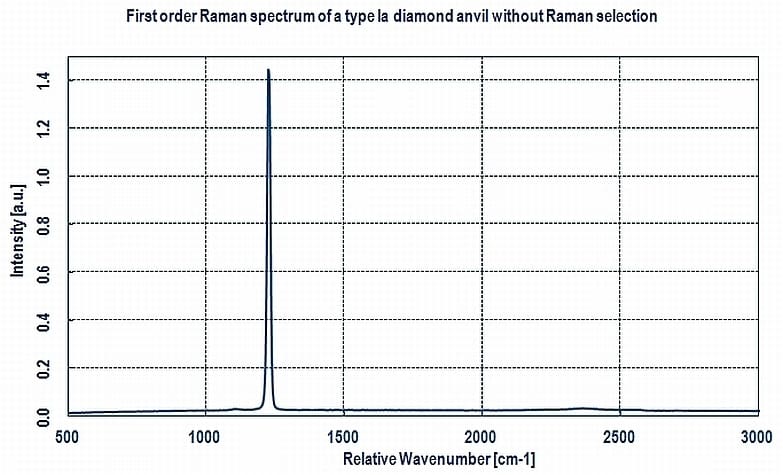 |
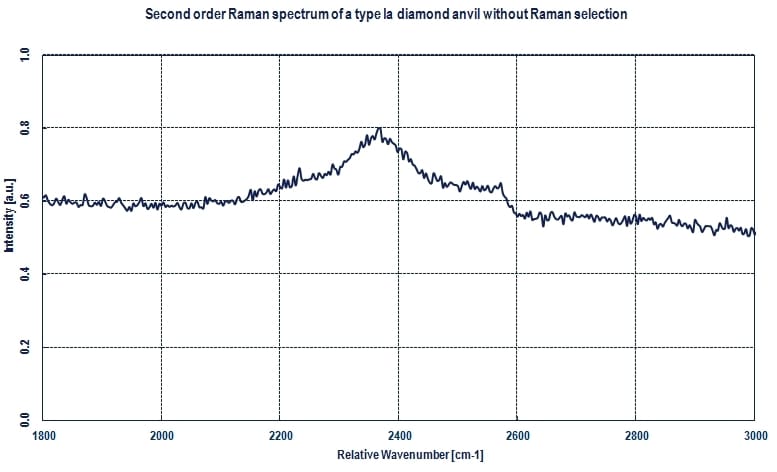 |
- Type Ia Raman low fluorescence – The intensity of the two-phonon Raman transition at 2664 cm-1 is at least 1.25 times the intensity of the background fluorescence of diamond
 |
 |
- Type Ia Raman ultra-low fluorescence – The intensity of the two-phonon Raman transition at 2664 cm-1 is at least 2 times the intensity of the background fluorescence of diamond
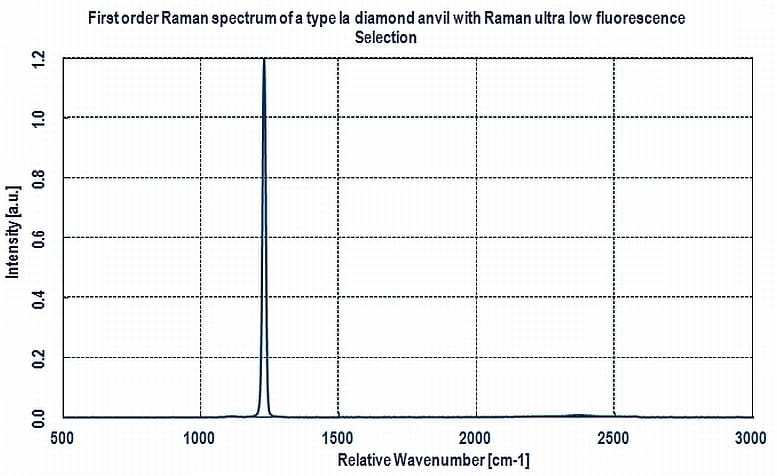 |
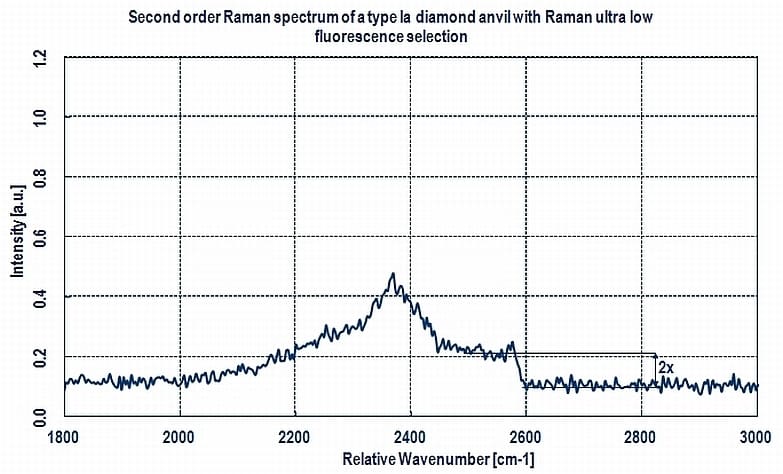 |
- Type IIac Raman ultra-low fluorescence
 |
 |
- Type IIas Raman ultra-low fluorescence – The intensity of the two-phonon Raman transition at 2664 cm-1 is at least 5 times the intensity of the background fluorescence of diamond
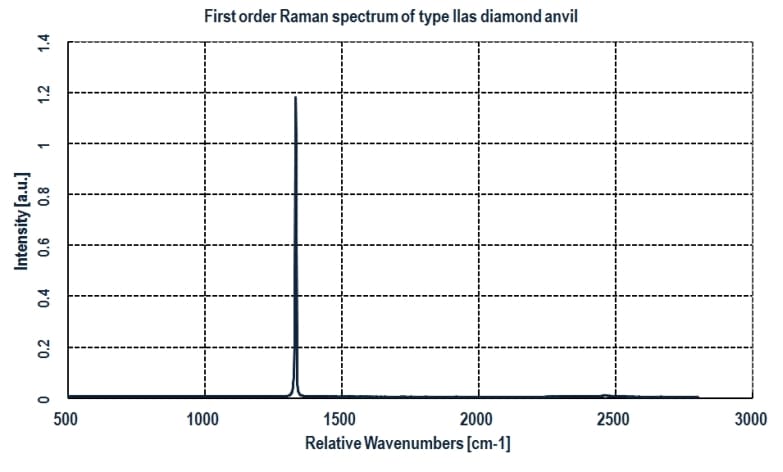 |
 |
BIREFRINGENCE
All diamonds to be used for anvil manufacture are examined under a polarising microscope for birefringence. Diamonds with significant birefringence discontinuity, typical of inclusions, etc. are rejected. In addition diamonds can be selected for ultralow birefringence. Total birefringence is measured using crossed polarisers, a waveplate and matched to specifications. Normally:
- Low birefringence <0.0001
- Ultra low birefringence <0.00005
Application
The Boehler-Almax diamond anvils can be used both for optical spectroscopy measurements and for X-ray diffraction where large apertures (up to 120°) are required. This design provides an optimised mechanical support for the anvil’s crown section achieved by a perfect match between the anvil and the tungsten carbide (WC) seat.
These anvils can be used in conjunction with:
Almax easyLab diamond anvil cells:
Optical: Diacell® μScopeDAC Plus and HeliosDACPlus.
X-ray: Plate DAC, Diacell® Bragg Plus and Bragg Mini, SymmDAC100, TozerDAC, One20DAC.
Newly designed or existing DACs (retrofit):
In most cases, the WC seat can be adapted to the dimension requirements of your DAC. Consult us.
Support Plate
Almax easyLab offers four types of WC seats which are represented below. At the time of ordering, you will be able to specify the key dimensions (D, H, T, S, A).
Boehler-Almax anvils are glued into their carbide seats. The gluing procedure can be received upon simple request or downloaded from our website. Open the Mountinginstructions03 document, or open the following You Tube 3 minute video clip. We can supply you with the appropriated gluiing jig.
|
Cylindrical
|
Cylindrical with top taper
|
| Tapered
|
Tapered with Top Taper
|
Documents
We have compiled a series of technical documents (brochures, articles, technical drawings, …) which you might find useful to help you understand this product better.
Technical documentation
Gridle and Crown Ground (ML23_06)
Type IIam diamond anvils for multi-megabar pressures (ML23_07)
Brochure Type IIas Diamond Anvils Extended
Brochure Type IIac Diamond Anvils Extended
Articles
2004 – Boehler, R. , De Hantsetters, K. – New anvil designs in diamond-cells
2008 – Moggach, S.A. et al. – Incorporation of a new design of backing seat and anvil in a Merrill–Bassett diamond anvil cell
2013 – Loubeyre, P. et al. – Hydrogen phase IV revisited via synchrotron infrared measurements in H2 and D2 up to 290 GPa at 296 K
2014 – Stinton, G. W. , MacLeod, S.G. at al. – Equation of state and high-pressure/high-temperature phase diagram of magnesium
2014 – Pepin, C. et al. – New Iron Hydrides under High Pressure
FAQs
How to chose the culet size ?
The culet size is to be decided as a function of the maximum pressure or the sample size. Typical sample space is given by the gasket thickness (typically 0.10 mm or less) and the central hole diameter (typically 30-50% culet size)
| Pmax (GPa) (*) | < 5 | 5-100 | > 100 |
| Culet size (mm) | > 1.00 | 1 -0.20 | < 0.20 mm, bevels up to 0.30 mm at 8° |
(*) The Pmax values are only indicative. The maximum pressure achievable with a DAC is influenced by many others experimental parameters, like the gasket characteristics (material, thickness and hole size) or the pressure transmitting medium.
How the culet looks like?
| Culet flat | Culet with single bevel | Culet with double bevel |
 |
 |
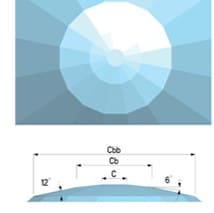 |
Examples of typical requests for quote:
Diamond anvil, type Ia, Boehler-Almax design, 16-sided, 2.50 mm – 30°, culet of 0.10 mm, bevels up to 0.30 at 8°, (100)-oriented, Raman low fluorescence, low birefringence.
- Article nr.: P01035
- Quantity: 6 anvils.
Diamond anvil, type Ia, Boehler-Almax design, 16-sided, 3.10 mm – 70°, culet of 0.30 mm, (100)-oriented.
- Article nr.: P01036
- Quantity: 4 anvils.

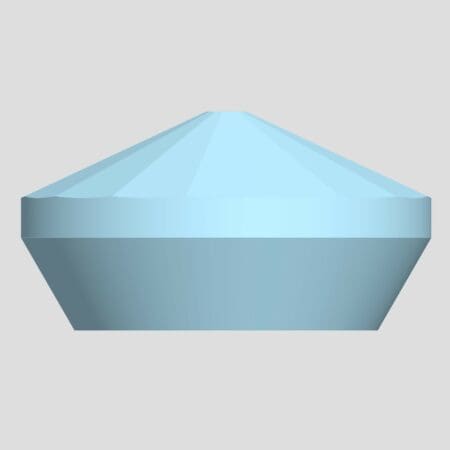

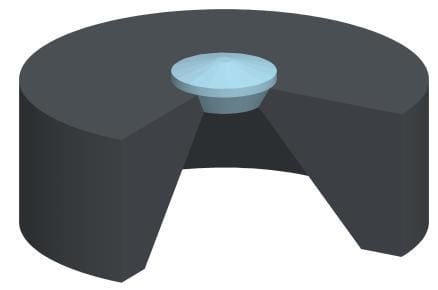
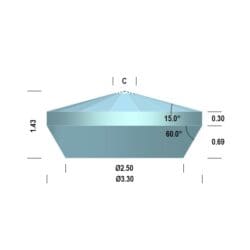
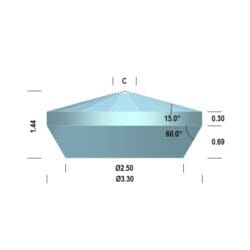

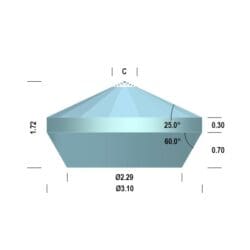
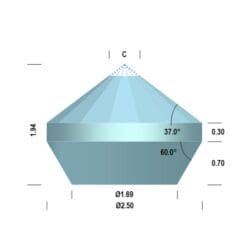
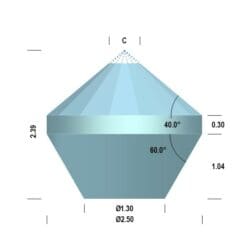
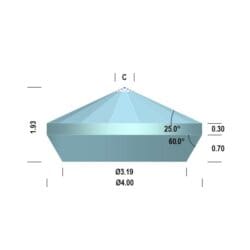
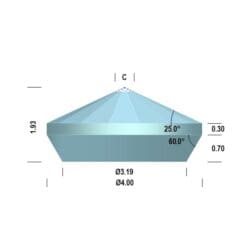
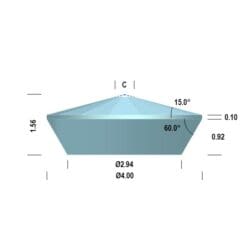
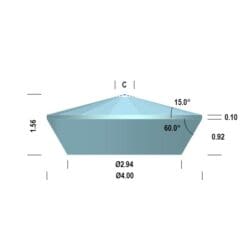

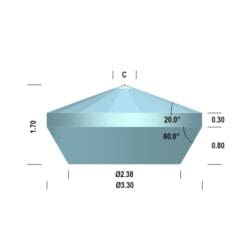
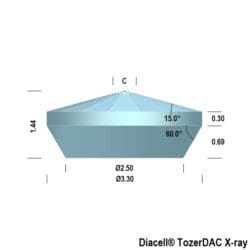
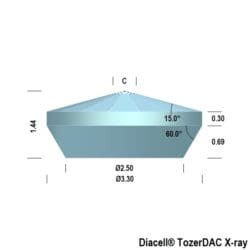
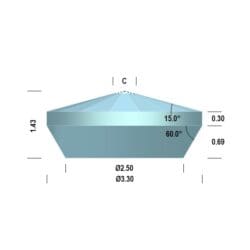
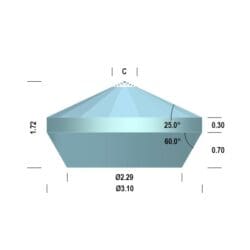
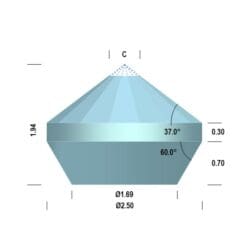
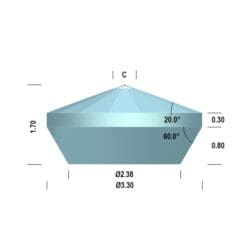
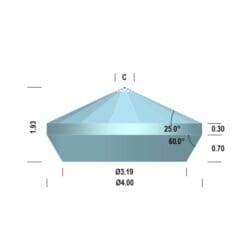
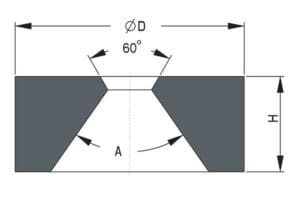

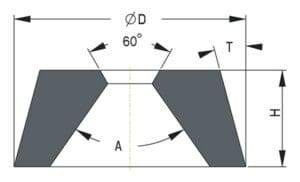


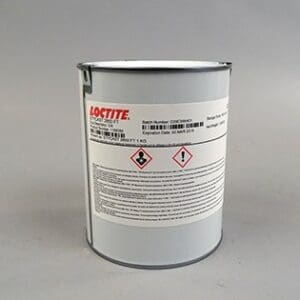


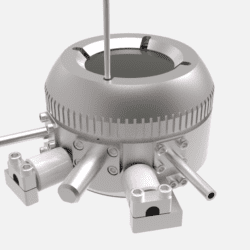
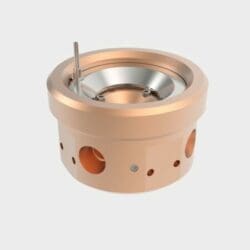


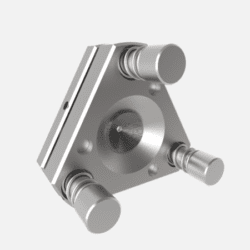
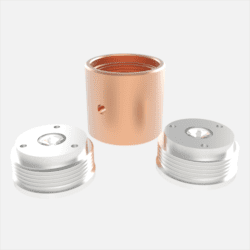
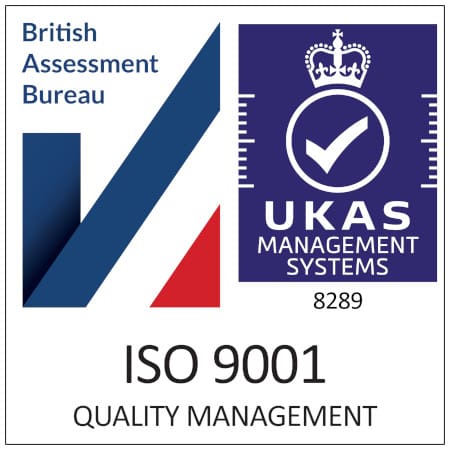
Reviews
There are no reviews yet.